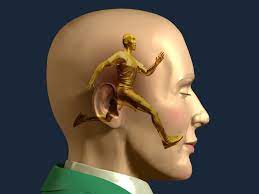
What is it and how can we use it to achieve the outcomes we want?
Most of us are probably familiar with goal-setting frameworks, such as SMART (goals should be specific, measurable, achievable, relevant, and time-bound). We have likely learned how to set goals but once that is done, what’s next? How can we support ourselves on the ‘implementation journey’?
Before we start, let’s quickly clarify the terms:
While ‘visualisation’ and ‘mental imagery’ are used interchangeably in some sources, the scientific definition of the two differs – visualisation is one part of mental imagery. If you imagine an object which you do not see in the outside world, it is a visual image in your mind (visualisation). Mental imagery however happens in all sense modalities (e.g., imagine how a warm bath feels or how a sour lemon tastes). It plays a crucial role in perception, but also in memory, emotions, language, desires and action-execution.
You are probably familiar with inspirational quotes like “If you can dream it, you can do it” by Walt Disney or “If you can visualise it, you can actualise it.” by athlete Dennis Conner. While these types of statements can sound cheesy and may be brushed off by some as being ‘too good to be true’, the point is: Using mental imagery and visualisation puts us at a competitive advantage and we have the science to back it up.
The brain, in many ways, does not distinguish real from imaginary!
Neuroscientific research found that imagination and perception rely on closely overlapping brain circuits. The brain encodes the vividness of perceived and real stimuli in almost the same manner, which means that the more vivid an imagination is, the more likely the brain is to perceive it as real. Dr. Dihkstra who researches the neural overlap of imagined and perceived stimulus representations (Human Neuroimaging @UCL) concluded the following: “There is no categorical difference between imagination and reality; instead, it is a difference in degree, not in kind.”
In daily life, we often imagine things that are not there – we switch between imagination and reality. For example, if I ask you what colour the entrance door of your house is, you are likely to see the door in front of your inner eye before answering the question. In this case you are probably aware that you are not standing in front of your house because it only is a short switch; a quick image. However, if someone would take you on a ‘trance journey’ and ask you to close your eyes and add further modalities to the imagination (e.g., smell the scent of the entrance hall), the experience becomes much more real.
How does knowing this help us?
One might think: “Great, now I know that I can play with imagination and reality but how does my brain’s confusion between the two benefit me in the outside world? Just because I mistake imagination for reality, reality in itself doesn’t change, right?”. Ignoring the fact that the definition of reality is a whole topic in itself, let’s take a step back and look at reasons why people do not achieve their goals: e.g., loss of motivation, fear of failure, low self-efficacy (the belief that you have what it takes to reach your goal), procrastination, overwhelm, lack of discipline. What do these reasons have in common? They are inner blockages. They are problems existing on a mental level which then manifest in the outside world (e.g., through self-sabotage or giving up). This is where mental imagery is offering support: it can help us restore a more helpful mindset which then leads to new bodily experiences and ultimately different results.
Mental imagery is an internal simulation of real-life events. The simulation feels real because our bodies have the same physiological responses to imagined (inside) vs. real (outside) input. For example, imagine a spider crawling out of your sweater and running up your neck into your hair. If you are scared of spiders, this will likely trigger tension in your neck muscles and increase your heart rate and cortisol levels. Or imagine you bite in a fresh slice of lemon and feel the juice in your mouth. For many, this triggers a contraction in facial muscles. Congratulations, your thoughts just became embodied!
How is this knowledge already being used to boost performance?
- In professional sports:
Athletes use visualisation techniques in preparation for competitions. The mental rehearsal of athletic achievements (especially when visualising the full sensory experience in real-time) stimulates the brain regions involved in movement and is priming the body for action. Also, the mental rehearsal (on top of the physical practice) helps athletes to better navigate the pressure at the time of competition. Athletes who have spoken in interviews about using visualisation techniques include Allyson Felix (Track and field athlete, Olympic Gold Medallist), Cristiano Ronaldo, and Michael Phelps (Swimmer, Olympic Gold Medallist).

- In physical therapy:
As mentioned, visualisation is highly effective in stimulating motor regions in the brain, which is used to support patients in regaining motor function, e.g., post-stroke. In 2014, a meta-analysis investigated the use of mental imagery on motor recovery, and five out of six studies yielded positive findings in favour of mental imagery. Another example of how the body follows the mind: in a randomised controlled trial of breast cancer patients undergoing chemotherapy, around half of the patients were asked to also imagine their immune cells like piranha fish and to imagine them destroying cancer cells. In those who visualised, immune system activity was significantly higher than it was in those who did not visualise. - In mental therapy:
Among other things, mental imagery is used to treat patients suffering from PTSD or phobias. Taking the example of phobias, mental training allows patients to slowly increase the vividness of their imaginations before being faced with real/outside triggers.
The whole point of this all is to work with your mind and to set yourself up for health and success.
Before we get into practical tips, I want to let you know:
If you would like to support my work, here’s a way: Ko-fi.com/neurosciencemusings. In case you choose to support: THANK YOU!
Now, how can we implement this into our own lives?
Five tips below:
- Timing: your subconscious mind is easier to access/ receptive in the transition periods between being awake and asleep. Try to visualise right before going to sleep or when waking up. Also, your nervous system is typically calmer and you are away from distractions. Another good time is right before or after your meditation as both are forms of mental training.
- Stating the obvious: Imagine as realistically as you can!Imagine you just achieved your goal: What will you see? What will you wear? What will the weather/season be like? What room/environment will you be in? What will it smell like? What can you taste? How will you feel? How will you celebrate after? Etc.
- Create a trigger/hook: You might be familiar with the concept of psychological conditioning where a given stimulus evokes a conditioned response. The idea of creating a trigger or hook is to connect a stimulus to your mental imagery training which can later on help to trigger the emotions you felt during the training. For example, if your goal is to give a speech in front of a large audience you can use a certain scent (e.g., an essential oil) every time you visualise how you successfully speak on stage. Before you go on stage, smell the essential oil (operating as the trigger) to help your body recall the previously experienced state more easily. (Smell, emotions, and memories are processed in the same brain regions, which is why odour is highly effective in triggering emotions and memories).
- Repeat: Practice makes perfect, so: repeat, repeat, repeat, …
- Vision boards: Creating vision boards has become a popular project on social media, especially amongst women. The idea is to print off or cut out photos which represent scenarios or things you want to experience more of in your life. The task prompts you to consider your goals, and keeping the finished board in your zone of attention (e.g., a wall you regularly look at) shall help you to keep your goals in mind, and to boost motivation and focus. (To flag, this practice lacks scientific research but has been claimed as highly effective by professionals across industries.)
Can everyone visualise?
The short answer is: no. The BPS (British Psychological Society) suggests that about 2-5% of the population have aphantasia, a condition which prevents people from visual imagery – they are blind in their mind/ have no mind’s eye. Interestingly, research suggests that people with aphantasia are significantly less likely to suffer from PTSD (as previously traumatic scenes cannot come up as flashbacks in their minds). Usually, people with aphantasia have access to other modalities (e.g., can form memories based on smell instead of images). However, a rare form of aphantasia is multisensory aphantasia in which case it is very difficult to form memories in general.

Conclusion – Mind Your Thoughts
Your brain is always working and processing information (even if it doesn’t feel like it at times ha). The number one priority of your brain is to keep you safe which is a good objective but it also means it is looking out for potential danger and has a bias towards focusing on the negative. It is easier to worry than to consciously create internal simulations of desired events (visualise). However, if we invest the time and awareness to practice mental imagery, we can support ourselves in creating the outcomes we want, which in my opinion is absolutely worth a shot.
Or how Aerosmith put it:

To share your thoughts and/or questions, reach me on instagram @neuroscience.musings or via the contact form on the website.
Best regards,
Sarah
Resources:
- Pascual-Leone, A., Nguyet, D., Cohen, L. G., Brasil-Neto, J. P., Cammarota, A., & Hallett, M. (1995). Modulation of muscle responses evoked by transcranial magnetic stimulation during the acquisition of new fine motor skills. Journal of neurophysiology, 74(3), 1037–1045.
- Munroe-Chandler, K. J., & Guerrero, M. D. (2017). Psychological imagery in sport and performance. In Oxford research encyclopedia of psychology.
- Nanay, Bence, “Mental Imagery”, The Stanford Encyclopedia of Philosophy(Winter 2021 Edition), Edward N. Zalta (ed.).
- Dijkstra, N., & Fleming, S. M. (2023). Subjective signal strength distinguishes reality from imagination. Nature Communications, 14(1), 1627.
- Burton, L., & Lent, J. (2016). The use of vision boards as a therapeutic intervention. Journal of Creativity in Mental Health, 11(1), 52-65.
- Ullsperger, M., Nittono, H., & Von Cramon, D. Y. (2007). When goals are missed: dealing with self-generated and externally induced failure. Neuroimage, 35(3), 1356-1364.
- Eremin et al., ‘Immuno-modulatory effects of relaxation training and guided imagery in women with locally advanced breast cancer undergoing multimodal therapy: A randomised controlled trial’, The Breast, 2009, 18, 17-25.
- https://www.bps.org.uk/research-digest/people-no-minds-eye-have-less-vivid-and-detailed-memories
- https://www.scientificamerican.com/article/dont-sleep-it-off/#:~:text=It%20may%20be%20tempting%20to,post%2Dtraumatic%20stress%20disorder%20symptoms
- https://josephgibson-63985.medium.com/be-wary-your-brain-doesnt-know-the-difference-between-reality-and-imagination-aba463709bda
- https://drdavidhamilton.com/real-vs-imaginary-in-the-brain-and-body/
- https://thereader.mitpress.mit.edu/meditation-and-the-unconscious-buddhism-neuroscience-conversation/
- https://www.birmingham.ac.uk/documents/college-les/sportex/imagery/introductiontoimagery-teachersnotes.pdf
- https://www.forbes.com/sites/daviddisalvo/2020/02/24/why-we-fail-to-reach-goals-our-brains-begin-with-one-focus-but-closing-the-deal-requires-another-study-suggests/


